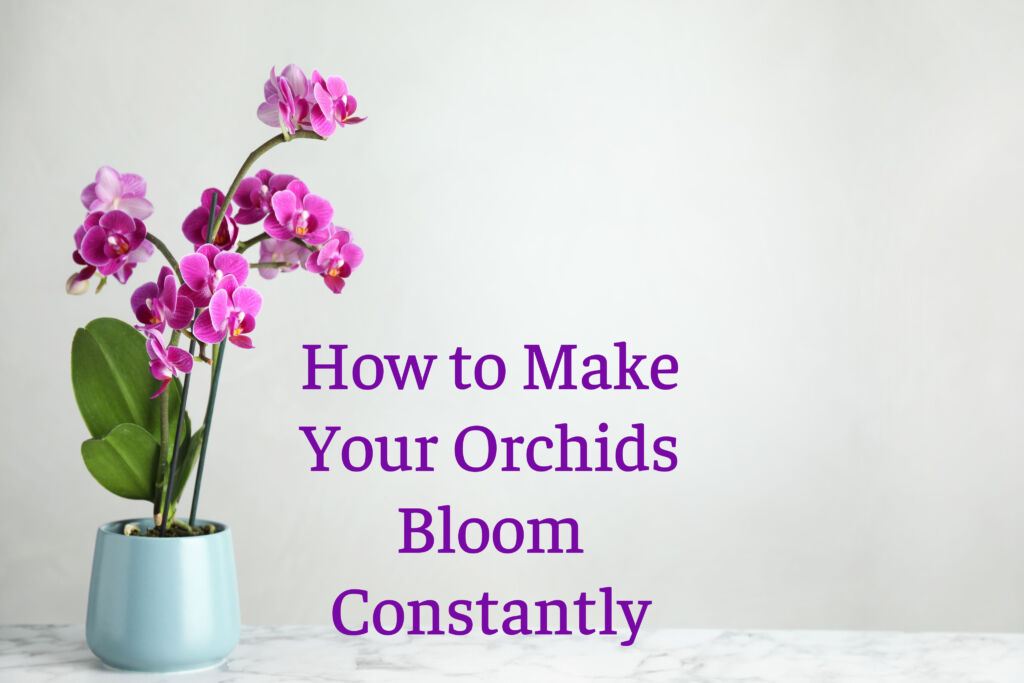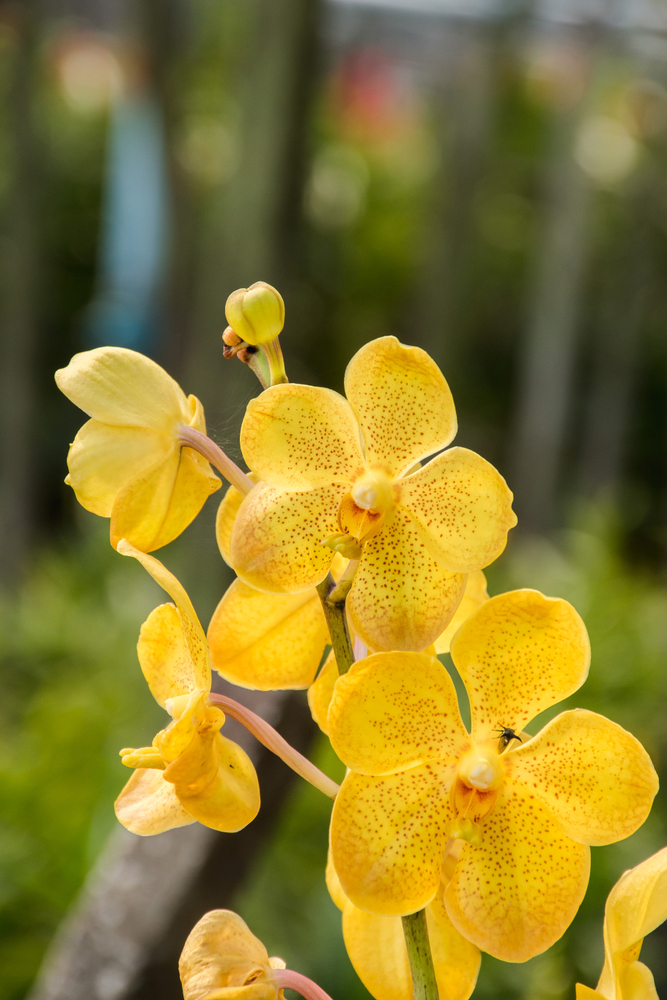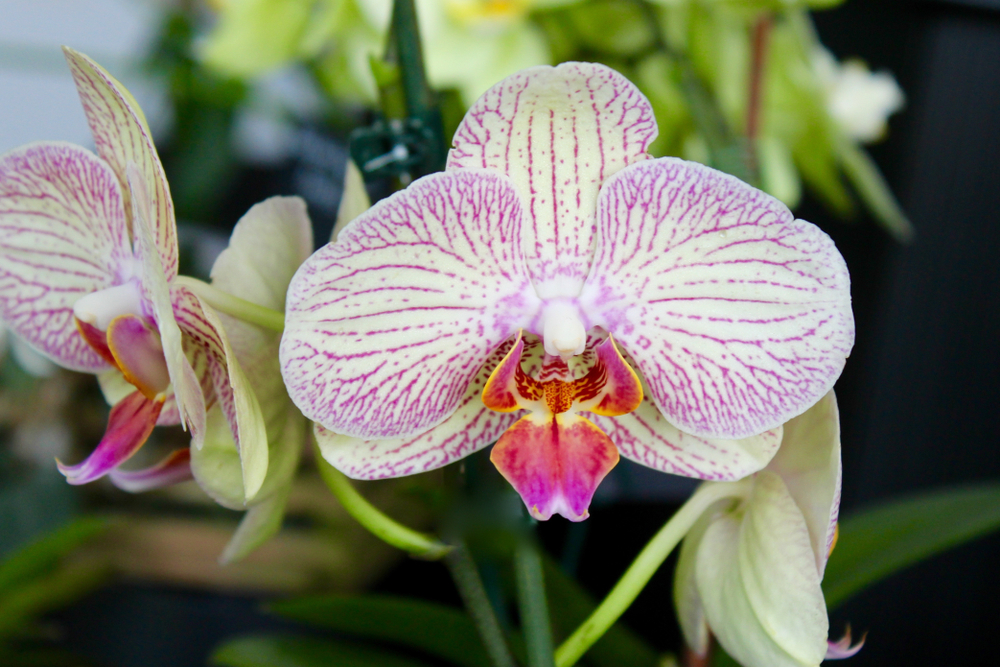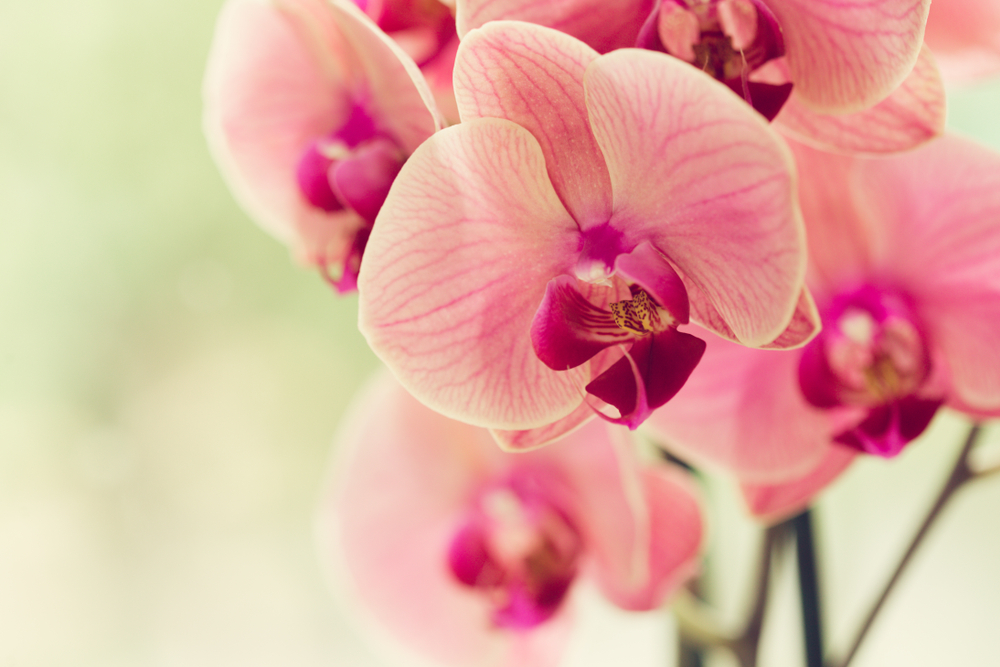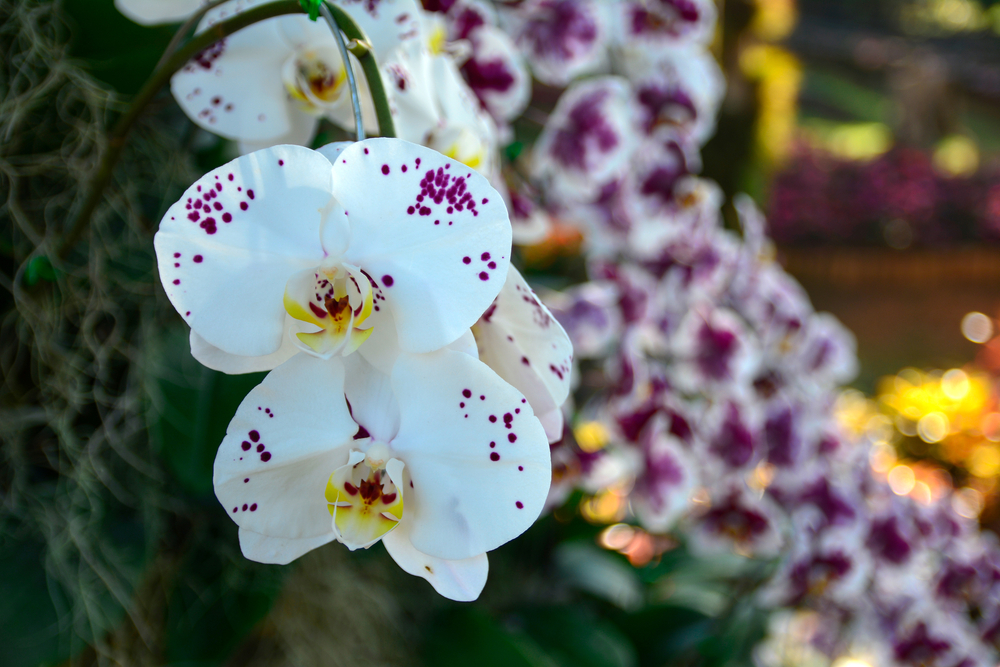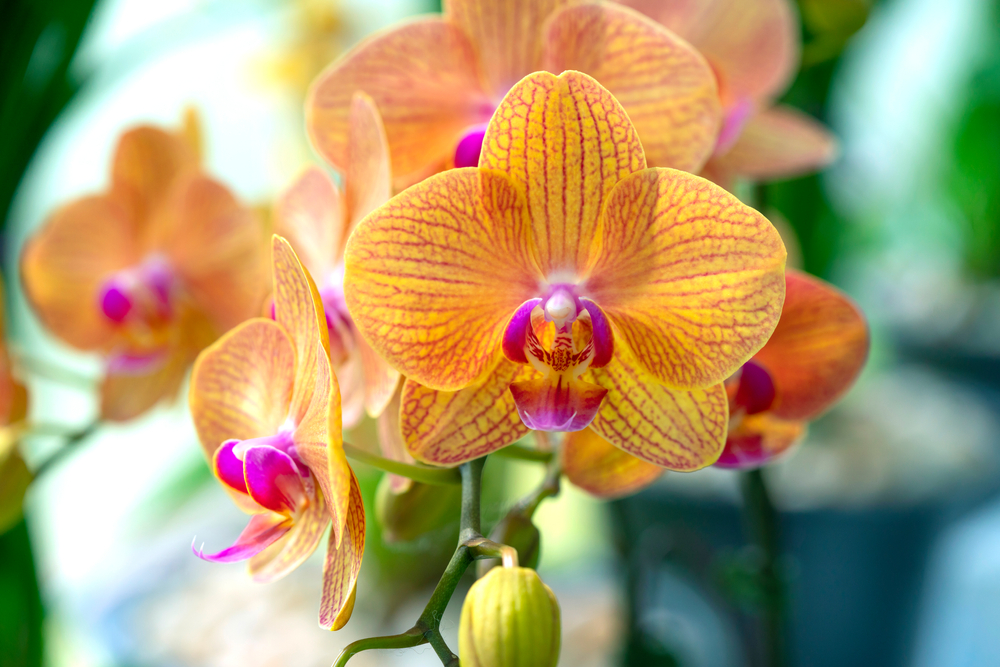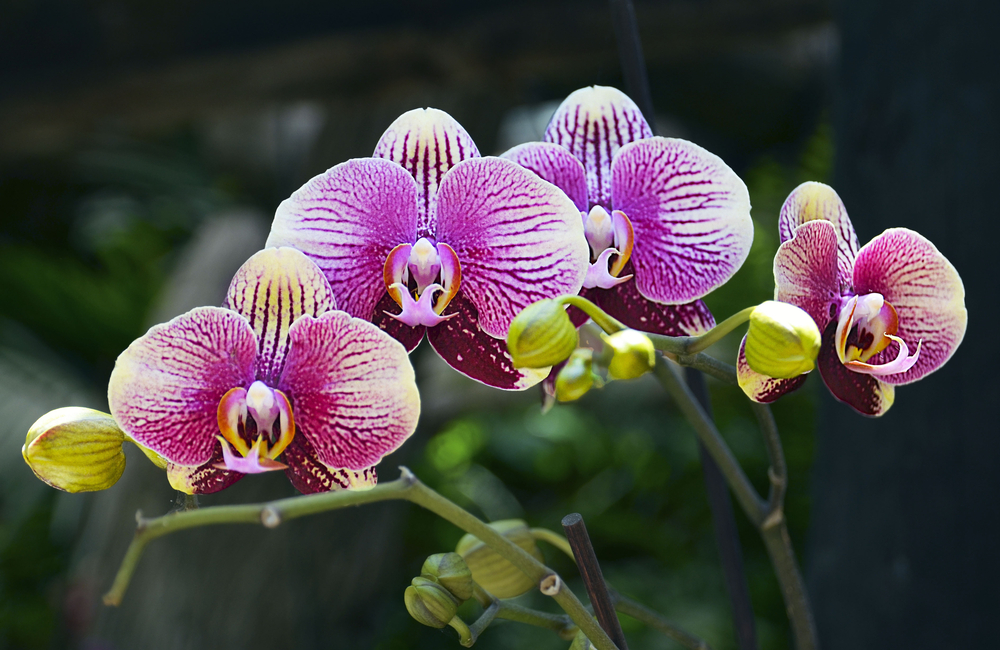HousePlantJoy is supported by our audience. When you purchase through one of our links, we may earn a small affiliate commission. As an Amazon Associate I earn from qualifying purchases. Your cost is not affected.
==================
Orchids symbolize elegance, love, and fertility and are often given as a gift to new parents. Learn these essential tips to know how to make your orchids bloom constantly?
Enthusiasts consider Orchids as one of the easiest growing plants if you know what they need. Their crisp color and long-lasting blooms produce incredibly beautiful flowers. Unlike other potted plants, orchids are epiphytes, meaning you can grow them by hanging on to trees rather than planting them in the dirt.
Different types require a different soil
However, semi-terrestrial orchid species like lady slippers can be grown in loamy soil. Depending on your orchid specie, they produce flowers in colors ranging from magenta, yellow hue, pink, white, or purple. The moth orchid type is one of the most common species, blooming twice a year with flowers lasting up to three months.
Some other common types of orchids include oncidium and dendrobium, which also bloom twice a year with flowers lasting a month or so.
I often asked, “how do I make my orchids bloom”?
The truth is making your orchids bloom is not difficult. So, if you are considering growing an orchid or want to give your orchid as a gift, follow our orchid guide to know how I make my orchids bloom.
How to Grow and Make My Orchids Bloom?
With more than 22,000 species of orchids around the world, there are a few factors that are essential for their growth. Potting, soil, watering, and adequate lighting are vital to making your orchid bloom constantly.
-
Potting to Make your Orchid Bloom
When planting your orchid, use a pot with plenty of drainages. In this regard, a pot with drainage holes at the bottom is perfect. It will help drain excess water completely. However, keep in mind that orchids never grow in pots in the wild – we use pots for our convenience.
For healthy growth and making your orchid bloom, their roots should be free and get plenty of airflow. However, we use pots since our homes do not support epiphytes due to insufficient humidity. If you see your orchid roots growing outside of the pot, it’s fine.
A pot also helps retain moisture for the roots. The secret to making your orchid bloom constantly is to keep its roots healthy. Your orchid roots also show the health of your plant. So, growing your orchid in the pots requires extra care to prevent root rot.
-
Soil Mix to Make Your Orchid Bloom
Apart from potting, using an appropriate mix is essential to make your orchid bloom. In this regard, using fast-draining soil is suggested. The orchid care will also vary depending on your chosen potting soil mix.
The perfect orchid mixes contain special Media to encourage good airflow and promote healthy growth. Remember that growing orchids in the dirt is never a good idea because it can smother the roots to kill your plant.
Start with the proper media.
For healthy growth and to make your orchids bloom constantly, they will need special media. So, the perfect media for your orchid is the one that perfectly matches your orchid type and the conditions you want to grow it in. However, with proper care, orchids can thrive in different conditions.
Mixing multiple media is an excellent idea because each ingredient brings unique, desirable characteristics to the potting mix. When choosing a potting mix, get an open and airy mix to bring an adequate amount of moisture your orchid needs.
Personally, I recommend using a bark-based or moss-based mix. The bark-based mix is perfect for draining the excess water, which means you will need to water your orchid more frequently. On the flip, a moss-based mix is perfect for retaining water, which means less frequent watering.
Since adequate moisture is vital for your orchid care, many gardening enthusiasts use clear pots. These pots make it easier to observe the roots.
-
Temperature Requirements to Make Your Orchid Bloom
Another critical factor for your orchid care is temperature. One of the best things that make orchids easy to grow plants is that they prefer temperatures well within the human comfort range. In order to make your orchids bloom, a daytime temperature of 75 F and a nighttime temperature of 65 F is ideal.
-
Light Requirements to Make Your Orchid Bloom
Light exposure is another factor that can impact your orchid growth. If your plant is not getting adequate lighting, you can expect lush growth but no flowers. Inadequate lighting is also one of the common reasons why orchids fail to bloom.
Keep in mind that orchids love to thrive and bloom in strong light. However, you should avoid exposing your orchid to direct sunlight. If you have orchids in your home, exposing them to bright but indirect light from a southern or eastern window is perfect.
In order to know whether your orchid is getting adequate light, you can observe its leaf color. If you notice bright, green leaves, it means your orchid is happy and healthy. Dark green leaves mean your plant is not getting adequate light. Similarly, red or yellowish leaves mean your plant is exposed to excessive light.
-
Watering
Watering is also essential to make your orchids bloom constantly. Incorrect watering is probably the most common cause of killing orchids. You should water your orchids only when they start to dry out. Overwatering can encourage root rot which kills the root. Since most orchids are tropical species, they don’t like watering with ice cubes.
When watering, pick up the potted orchid to see if the potting mix is drying out. Moreover, a few other indicators of a thirsty orchid plant include plump white, shriveled gray, or spongy brown and black roots.
-
Fertilizing
Fertilizing your dormant orchid is very important if you want to make it rebloom. In this regard, the rule of thumb is to use a balanced houseplant fertilizer (i.e., 20-20-20) weekly or monthly. Due to the diverse care needs, it would be great to use an orchid-specific fertilizer to make them grow really well.
Unlike many other flowering plants that need fertilizer during their active flowering period, feeding your orchids with fertilizer is most critical when vegetative growth occurs. Once your orchid starts blooming, fertilizer can be withheld until your plant completes its next dormant period and starts to emerge into its active growth.
“According to gardening enthusiasts, three weeks on and one week off routine is great to make your orchids bloom constantly. It means you can fertilize your plant weekly for three weeks and then take a week off. This strategy will help flush any built-up salt out.”
When fertilizing your orchid, keep these tips in mind:
- Use a fertilizer with equal amounts of potassium, nitrogen, and phosphorus. Look on the fertilizer label to make sure that 20-20-20 is written on it.
- Make sure to use the fertilizer at half-strength. You can mix it with equal water before feeding it to your orchids.
- Using a narrow-spouted pitcher is helpful to avoid leaves and slowly pour the fertilizer into the pot.
- Make sure to drain excess solution out.
- Avoid watering during fertilizing days.
-
Provide Humidity to Make Your Orchids Bloom
Sufficient humidity is critical to making your orchids bloom. Since orchids have a tropical origin, they grow very well in warm, bright, humid spots. Inadequate humidity can make brown tips on leaves and stunt your orchid’s growth. Moreover, it can also encourage bud blast and leaves wrinkling, resulting in malformed flowers.
During the winter, homes with forced-air heating systems have a humidity level of about 15%. Since this is the average humidity in most desert areas, you will have to raise humidity levels to at least 50%. In this regard, you can use a room humidifier.
Which humidifier?
I recommend using an evaporative-pad humidifier rather than a mist humidifier. It is because, unlike a mist humidifier, an evaporative-pad humidifier does not leave your plant with a white film. Another tip to increase humidity is to grow plants on a waterproof tray packed with pebbles. Add water to the tray, and then put your orchid on top of damp gravel.
Another way to increase humidity is misting. While this works fine, you have to do it multiple times a day to be effective. The issue with misting is that if the water source is mineral-laden, your plant’s leaves may become encrusted in white. Using distilled water can prevent this problem.
-
Avoid Cutting the Roots
Depending on the variety, your orchid roots might start growing up and over the pot – don’t cut them. It’s okay as these roots provide more energy to your plant. Cutting these roots means there’s a good chance that you will cause harm to your plant or introduce a dangerous virus.
However, you can trim your plant roots or stem only if it is dry and certain it’s dead. If you spot the roots growing up and over the pot, this may be ideal for checking your pot size. If your plant seems a little too snug, use a larger container to repot your orchid.
-
Re-Pot Your Orchid
Unlike many other houseplants, orchids don’t require regular repotting and grow well when root-bound. However, after three or four years, it is wise to take them out of their containers and remove the compost.
If your orchid is potted in moss and you are worried about root rot, you should consider changing out the potting mix for something that allows air to get down into the roots and drain quickly. Moreover, if your orchid is top-heavy and the roots start exploding out of the container, it’s time to repot your plant.
Here’s how you can report making your orchid bloom constantly:
- Make sure you have a small bag of orchid potting mix.
- Use a plant pot that should be a few inches larger than your previous post.
- Use gentle hands to remove your orchid from its original pot carefully.
- If you spot any rotten-looking roots or potting mix, remove it.
- Now, place the orchid root ball into the new pot and gently push pieces between the roots.
- Don’t forget to include the stem support stick.
- Soak for at least thirty minutes, drain, and put it in a bright spot.
Do Orchids Bloom More than Once?
So, do orchids bloom more than once? Yes, it is possible to make your orchids rebloom. I have had tremendous success with my orchids. According to gardening enthusiasts, orchids will be best grown and encouraged to rebloom if nightly temperature fluctuations occur. Remember that if you want to make your orchids bloom constantly, you have to keep your home cooler during the winter.
A few tips to make your orchids bloom more than once are:
- Look for any dead flowers and pluck them off. You should also cut the flower stalk if it’s dead.
- Keep your orchids in a bright spot. The best place to put your orchids is closer to windows because that’s where temperature fluctuations occur.
- Continue watering as usual and wait patiently.
- Cut the old flower stalk down if you cannot spot any new flower buds or flower stalks after six months.
- Still, if you haven’t spotted a new flower growth, the best you can do is to move your plant to a different spot. You can also try feeding your plants with a bit of fertilizer or changing your watering routine.
How Long Do Orchids Bloom?
One of the common types of orchids is phalaenopsis which usually blooms for up to four months. However, the blooming time depends on the condition of your plant. Usually, orchids can bloom twice a year and live for decades.
Some other orchid varieties and their blooming during are listed below:
- Cattleya orchids: up to 21 days.
- Oncidium orchids: 4 to 6 weeks.
- Paphiopedilum: 6 to 8 weeks.
- Phalaenopsis: 8 to 16 weeks.
- Dendrobium: 6 to 12 weeks.
How to Make your Orchids Bloom Longer?
There are various techniques that you can try to make your orchids bloom longer:
-
Pick a Good Orchid
You might get tempted to pick an orchid with spectacular flowers when buying orchids. This usually means the plant’s flowering phase is nearer to the end than the beginning. You may also find that your orchid blooms for only a few weeks before its flowers fall off the plant.
It is wise to pick an orchid healthy, strong flower spike. It should have some unopened buds and signs that the flower spike is still growing and encouraging new flower buds. Busing a healthy and strong orchid can ensure that you’ll have months of new flowers to enjoy.
-
Temperature Control is Critical to Make Your Orchids Bloom Longer
Keeping your plants a little cool ensures the stimulation of the flowering process and helps slow the growth and extend the flowering time. When buying and transporting your orchids to your home, keep them away from stress and harsh weather conditions.
At home, the ideal temperature for common orchid varieties ranges from 64F to 77F. Additionally, avoiding swift changes in the temperature can also help make your orchids bloom longer.
-
Appropriate Light Exposure Can Help Make your Orchids Bloom Longer
Exposing your orchids to indirect but bright light and placing them in conditions with adequate lighting can help extend their blooming duration. Inadequate light decreases photosynthesis, which can impair the ability of your plant to maintain the current blooms. Moreover, excessive direct sunlight can also cause scorching of the leaves and flowers.
-
Watering Can Also Help Make Your Orchids Bloom Longer
Your watering routine impacts the health of your orchids and bloom time as well. So, make sure to pot your orchids in a well-draining medium with many drainage holes. Making your plant sit in water for long can lead to suffocation and root rot.
Wrapping Up
That’s all about how to care for your orchids and how to make your orchids bloom constantly. With proper care, orchids can live for a year or even decades. An orchid’s lifecycle includes an initial bloom during fall, a dormant period, and a rebloom. Applying these tips will surely help you make your orchids bloom longer.
Read More

